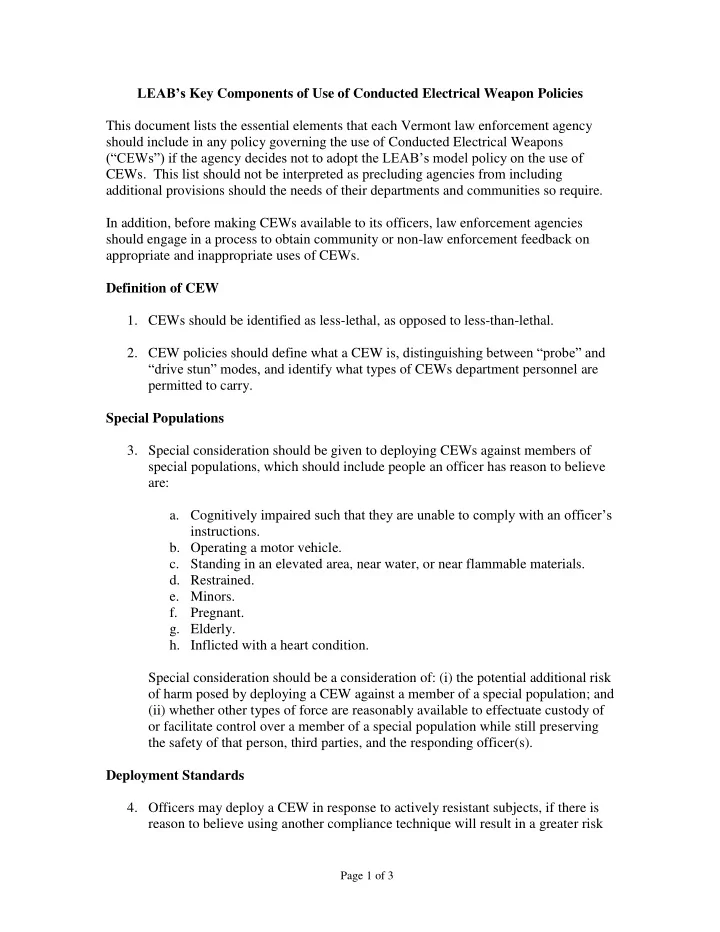

LEAB’s Key Components of Use of Conducted Electrical Weapon Policies This document lists the essential elements that each Vermont law enforcement agency should include in any policy governing the use of Conducted Electrical Weapons (“CEWs”) if the agency decides not to adopt the LEAB’s model policy on the use of CEWs. This list should not be interpreted as precluding agencies from including additional provisions should the needs of their departments and communities so require. In addition, before making CEWs available to its officers, law enforcement agencies should engage in a process to obtain community or non-law enforcement feedback on appropriate and inappropriate uses of CEWs. Definition of CEW 1. CEWs should be identified as less-lethal, as opposed to less-than-lethal. 2. CEW policies should define what a CEW is , distinguishing between “probe” and “drive stun” modes, and identify what types of CEWs department personnel are permitted to carry. Special Populations 3. Special consideration should be given to deploying CEWs against members of special populations, which should include people an officer has reason to believe are: a. Cognitively impaired such that they are unable to comply with an officer’s instructions. b. Operating a motor vehicle. c. Standing in an elevated area, near water, or near flammable materials. d. Restrained. e. Minors. f. Pregnant. g. Elderly. h. Inflicted with a heart condition. Special consideration should be a consideration of: (i) the potential additional risk of harm posed by deploying a CEW against a member of a special population; and (ii) whether other types of force are reasonably available to effectuate custody of or facilitate control over a member of a special population while still preserving the safety of that person, third parties, and the responding officer(s). Deployment Standards 4. Officers may deploy a CEW in response to actively resistant subjects, if there is reason to believe using another compliance technique will result in a greater risk Page 1 of 3
of injury to the officer, the subject, or a third party, and in response to assaultive subjects when lethal force does not appear to be objectively reasonable. 5. Neither an officer, a subject, or a third party has to actually suffer an injury before an officer is permitted to use a CEW and officers are not required to use alternatives that increase the danger to themselves or the public. 6. When it is safe to do so, officers should attempt to deescalate situations by their presence or through the use of verbal persuasion. 7. When it is safe to do so, officers should provide a warning prior to deploying a CEW. 8. Officers should attempt to avoid deployment to a suspect’s head, neck, chest, genitals, female breast, and stomach of a pregnant woman. 9. CEWs shall not be used in a punitive or coercive manner and shall not be used to awaken, escort, or gain compliance from passively resistance subjects. The act of fleeing or destroying evidence, in and of itself, does not justify the use of CEWs. Post Deployment Procedures 10. Medical attention should be offered to all individuals against whom a CEW has been deployed. 11. Emergency medical services shall be contacted if a subject: a. Suffers an obvious injury. b. Does not appear to recover properly and promptly after deployment. c. Is a member of a special population. d. Has been subjected to three or more CEW deployments or a continuous deployment exceeds 15 seconds. e. Exhibits signs of extreme uncontrolled agitation or hyperactivity prior to the CEW exposure or the subject was involved in a lengthy struggle or fight prior to the CEW exposure. 12. Officers should complete a use of force after deploying a CEW or displaying a CEW for compliance purposes. 13. All use of force reports shall be reviewed by the officer’s supervisor. The department shall conduct a use of force review in the following circumstances: a. The department receives a complaint of excessive use of force. b. The supervisor recommends conducting a use of force review. c. The encounter resulted in death or serious bodily injury. Page 2 of 3
d. The individual is exposed to the CEW is a member of a special population. e. An individual was exposed to three or more CEW cycles or a cycle that lasted longer than 15 seconds. f. Upon request, a suspect subjected to a CEW deployment shall be kept informed of the procedural status and final result of the review. 14. Annually each law enforcement agency shall report to the Vermont Criminal Justice Training Council the total number of CEW deployments during the previous year and how many deployments resulted in a use of force review. The Council shall make this information available on its website. Training Standards 15. Training for officers authorized to carry a CEW shall be conducted annually. 16. Training shall also incorporate, at a minimum: a. Instruction on the use of force continuum. b. Techniques to avoid or deescalate confrontations. c. The underlying technology and operation of CEWs. d. The physiological effects upon an individual against whom such an CEW is deployed. e. The proper use of the weapon, including both the proper mechanical use of the weapon and the circumstances under which it is appropriate to use the weapon. f. Scenario-based training. g. Proper removal of CEW probes. h. The potential medical needs of a subject who has been subjected to an CEW deployment. i. The post-deployment reporting requirements. j. Instruction on interacting with individuals experiencing a mental health crisis, as recommended by the Vermont Criminal Justice Training Council. 17. Departments should also evaluate the value of requiring or allowing officers to feel the effects of a CEW as part of training. If an officer decides to feel these effects, the training shall include an explanation of the potential differences between that officer’s experience and the experience of a subject in the field. 18. Training shall not be restricted solely to training conducted by the manufacturer of the CEW. Page 3 of 3
Recommend
More recommend